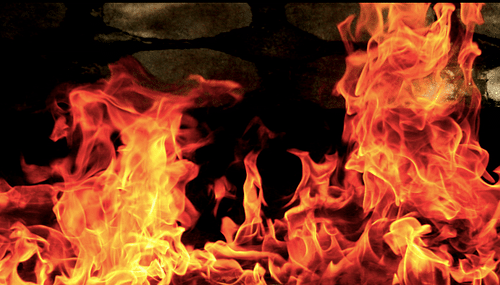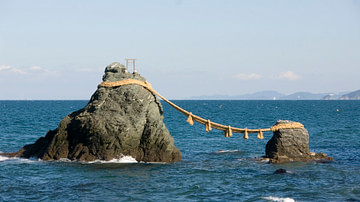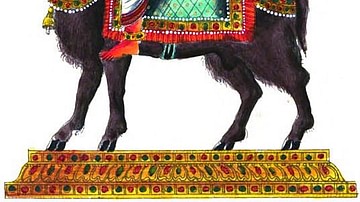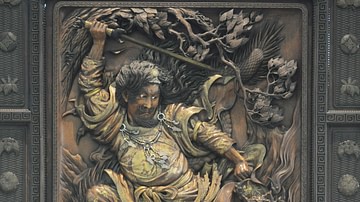
Kagutsuchi (aka Hi-no-Kagutsuchi) is the Shinto god or kami of fire and is also known as Homusubi. The son of Izanami and Izanagi, the fire god is the father of eight warrior gods and eight mountain gods, amongst others. Such a destructive force as fire in a culture where buildings were typically made of wood and paper resulted in Kagutsuchi becoming an important object of Shinto ritual and a frequent receiver of appeasing offerings.
Genealogy & Offspring
According to the 8th-century CE Kojiki ('Record of Ancient Things') and Nikon Shoki ('Chronicle of Japan' and also known as the Nihongi), Kagutsuchi-no-kami, to give his full name, was born from Izanami, one of the Shinto creator gods, but such was his fierce heat that he killed his mother in the process. His father Izanagi was not best pleased with this result and so lopped off Kagutsuchi's head with his great sword, the Ame-no-o-habari-no-kami. From the blood which gushed out over the surrounding rocks and dripped from the sword's blade and hilt another eight gods were born, all of them powerful swordsmen kami. The two most important of these martial gods are Takemikazuchi-no-kami and Futsunushi-no-kami, with the former being also a thunder god and patron of the martial arts who famously subdued Namazu the giant catfish that lives beneath the earth and causes earthquakes by flipping his tail.
Two other gods born from Kagutsuchi's blood were Kuraokami-no-kami, who is mentioned in the Manyoshu poem anthology (compiled c. 759 CE) as being a dragon and rain god. Another is Amatsumikaboshi, the kami of Venus, the Evening Star. Her alternative name is Amenokagasewo.
After Kagutsuchi's decapitation the story continues and from just about every body part of the fire god, from his left foot to his genitals, eight more gods were born. These were mountain gods which represented different types of mountains such as forested ones, those with moors, those far away, those possessing iron, those which provided passes to adjoining valleys and, of course, volcanoes. The stories of Kagutsuchi which include the creation of iron and swords may well be a mythological explanation for the arrival of iron and superior metal goods via immigrants arriving in Japan from mainland Asia at the beginning of the Yayoi Period (c. 300 BCE or earlier to c. 250 CE), many of whom may well have been warriors.
In an alternative version, or rather an added segment, recorded in the 10th-century CE Engishiki, before she dies Izanami hides away and gives birth to three more gods: the water kami Mizuhame-no-mikoto, the clay princess, the gourd, and the water reed. All four are instructed by their dying mother to watch out for Kagutsuchi and, if necessary, act to pacify him if he ever gets out of hand. The traditional fire-fighting equipment of the ancient Japanese was water, carried in a gourd, to pour on the fire while water reeds and clay were often used to smother it. Even today in some parts of Japan, there is a midwinter ritual where reed bundles are placed in the eaves of roofs so that they are handy if a fire should break out.
Fire in Shinto Rituals
The Japanese have long since had a great fear of fire and the devastation it can cause, not least because Japanese buildings were traditionally made from highly combustible wood and paper walls with wood shale or grass roofs. Fires have destroyed almost every major ancient building and temple in the ancient cities of Japan over the centuries, and during the Edo period (1603-1868 CE), fires were so frequent at the capital Edo (modern Tokyo) that they were known as 'the flowers of Edo'.
It is not surprising then that ceremonies to appease and ward off Kagutsuchi were a common feature of Shinto ritual. In such rituals and prayers, Kagutsuchi is usually referred to as Homusubi, which translates as 'he who starts fires'. The ancient Japanese even dedicated a twice yearly ceremony to Kagutsuchi, the Ho-shizume-no-matsuri, which was sponsored by the imperial court whose sprawling palace complexes were frequently victim to fires. The ceremony was designed to please the god and ensure he would withhold his terrible flames for another six months. The destructive fire of Kagutsuchi is in contrast to the purifying fire of Shinto rituals, known as kiri-bi, which was traditionally made by rubbing together two pieces of hinoki wood, a type of cypress.
Kagutsuchi is sometimes equated with Atago Gongen, another kami of fire and considered an avatar of the Buddhist figure Jizo. Strictly speaking, though, Atago Gongen is a more positive figure in Japanese mythology and acts as a protector from fire or a preserver of it.
This content was made possible with generous support from the Great Britain Sasakawa Foundation.





